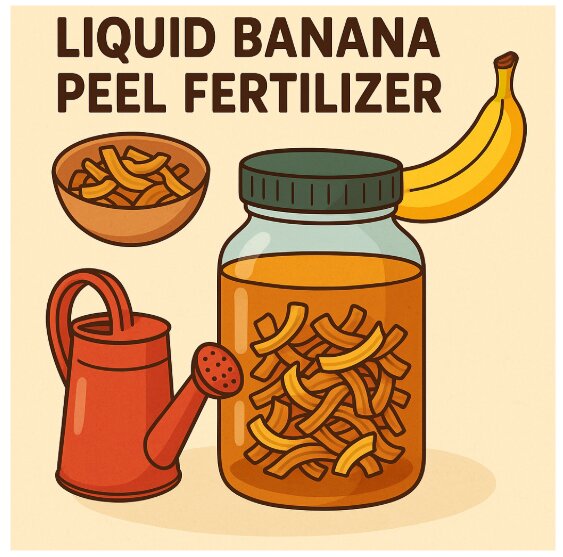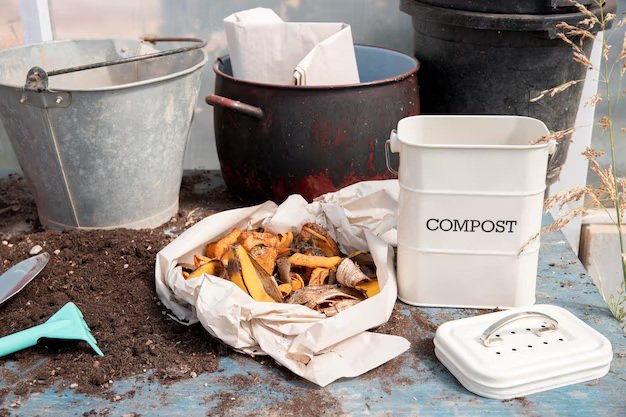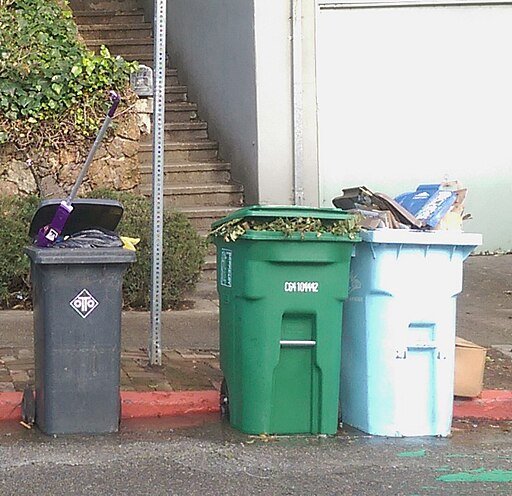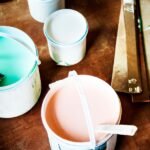How to Use Dried Banana Peel as Fertilizer: A Natural Boost for Plant Growth
Growing up, I remember watching my grandmother carefully lay banana peels on old zinc sheets under the sun. She’d say, ‘Waste nothing; even a banana peel can bless your harvest.’ Back then, I didn’t grasp the depth of her wisdom. Now, I see that every banana peel is more than just waste—it contains nutrients that can truly benefit your garden.
Banana peels are rich in potassium, phosphorus, calcium, magnesium, and sulfur—essential nutrients that plants need to thrive. Potassium aids in root development and disease resistance, phosphorus promotes blooming and fruiting, calcium strengthens plant cell walls, magnesium is vital for photosynthesis, and sulfur supports protein synthesis. These nutrients are naturally present in banana peels, making them a valuable addition to compost or as a direct soil amendment.
Recent studies have highlighted the benefits of using banana peels as fertiliser. For instance, research published in the journal Agriculture found that biofertilizers made from banana peels can significantly improve soil quality and crop yields. By drying and grinding banana peels into a powder, gardeners can create a slow-release fertiliser that nourishes plants over time.
Embracing this natural approach not only recycles kitchen waste but also enriches our gardens sustainably. It’s a simple, effective way to honour traditional wisdom while supporting modern ecological practices.

In This Article
- Preparing Dried Banana Peels for Your Garden
- Application Methods in Different Garden Setups
- What Plants Benefit Most from Banana Peel Fertiliser?
- Environmental and Economic Impact
- Challenges and Tips for Best Results
- Conclusion: Actionable Takeaways:
Preparing Dried Banana Peels for Your Garden
Method 1: Sun Drying – A Natural Classic
If you live in a warm, sunny climate, sun drying is the most eco-friendly and cost-free method. Just lay your banana peels flat on a mesh tray or a clean metal sheet (like zinc or stainless steel works great). Make sure they’re not stacked—give each peel room to breathe.
Turn them every 12 hours to ensure even drying. In direct sunlight, it usually takes 2 to 3 days for the peels to become crispy and fully dehydrated. They’ll shrink, darken, and curl slightly—that’s completely normal. If humidity is high, consider bringing them inside overnight to avoid moisture buildup.
Method 2: Oven Drying – Great for Urban Gardeners
If you don’t get enough sun or live in an apartment, the oven is your best bet. Set it to the lowest possible temperature—around 150°F (65°C) is ideal. Spread your banana peels on a baking sheet lined with parchment paper. Bake them for 1 to 2 hours, flipping once halfway through.
You’re aiming for a brittle texture, not charred. Keep an eye on them during the last 20 minutes—every oven is a little different. Once done, let them cool completely before storing.
Method 3: Dehydrator Drying – Clean, Fast, Reliable
Got a food dehydrator? This method is the most consistent and clean. Set it to 135°F (57°C), and lay the peels on the trays in a single layer. Let them dry for about 6 to 8 hours until they snap easily.
Once fully dry using any of these methods, you can break the peels into pieces or pulse them into a fine powder using a blender or food processor. Powdered banana peel is easy to sprinkle around plants, mix into compost, or add to soil blends.
Pro Tip: Store the dried pieces or powder in an airtight container in a cool, dark place. They’ll last for months without losing potency.
Application Methods in Different Garden Setups
1. Direct Soil Amendment
The simplest method is to mix the powder straight into the soil. Just add 1 to 2 tablespoons of dried banana peel powder into the planting hole or gently work it into the top layer of soil around your plants once a month. This method is especially great for nutrient-hungry crops like tomatoes, flowering plants, and fruit trees. The potassium and phosphorus in banana peels support strong root growth, vibrant blooms, and better fruit production.
This isn’t just anecdotal—plants often respond well to slow-release nutrient sources like dried peels. A 2020 study in the Journal of Soils and Sediments found that a slow-release bio-organic chemical fertiliser significantly boosted tomato growth, with enhanced root development linked to gradual nutrient availability and increased microbial activity in the soil

2. Compost Booster
Adding dried banana peels to your compost bin is more than just a smart way to cut down on kitchen waste—it’s a science-backed strategy for enriching your compost. Banana peels are naturally high in essential nutrients like potassium and phosphorus, which help balance carbon-heavy materials such as dry leaves and cardboard. When the peels are dried and chopped beforehand, they decompose more quickly, making their nutrients readily available to soil microbes and plants.
A 2022 study published in Frontiers in Environmental Science found that compost made from banana peels significantly improved the availability of nitrogen, phosphorus, and potassium in the soil, boosting overall plant performance.

3. Liquid Banana Peel Fertiliser (Banana Tea)
Soak 1 cup of banana peel powder in a litre of water for 24 to 48 hours. Once it’s steeped, strain the liquid and pour it around the base of plants or spray it directly on leaves as a foliar feed.
This banana “tea” gives your plants a quick potassium boost, particularly useful during flowering or fruiting stages. It’s gentle, organic, and easy to make from your kitchen scraps.

4. Container Gardening & Seedling Mixes
If you’re working with potted plants or starting seeds, mix 2–5% dried banana peel powder into your potting soil. This gives seedlings a steady supply of nutrients from the very beginning.
It’s a small addition that can make a big difference. Young plants benefit from trace minerals and phosphorus during root development, setting the stage for healthy growth.
What Plants Benefit Most from Banana Peel Fertiliser?
- Tomatoes: Tomatoes thrive on potassium, which supports fruit development and overall plant vigour. A study published in Frontiers in Plant Science found that applying dried plantain peel (a close relative of banana) combined with Tithonia diversifolia leaves significantly increased tomato fruit yield and enhanced antioxidant content, including lycopene and vitamin A.
- Roses: Roses benefit from the phosphorus and potassium in banana peels, leading to more abundant blooms and stronger stems. While specific studies on roses are limited, the general nutrient profile of banana peels supports flowering plants.
- Peppers: Peppers, like tomatoes, are heavy feeders that respond well to potassium-rich fertilisers. A 2021 study published in Plants (PMC8227464) explored the effects of banana peel-derived nano-NPK fertilisers on Capsicum annuum (a common pepper species) and found significant improvements in plant growth, fruit yield, and quality.
- Orchids: Orchids, known for their delicate nature, can benefit from the gentle nutrient release of banana peel tea. While direct studies are scarce, anecdotal evidence suggests that banana peel infusions can enhance root growth and leaf colour in orchids
- Fruit Trees: Fruit trees require a balanced nutrient supply for healthy growth and fruit production. The minerals in banana peels, particularly potassium and calcium, support root development and disease resistance. Although specific studies on fruit trees are limited, the nutrient content of banana peels aligns with the needs of these plants.
- Leafy Greens: Leafy greens like spinach and lettuce can benefit from the trace minerals in banana peels. However, they primarily require nitrogen for optimal growth, so banana peels should be used in conjunction with nitrogen-rich fertilisers for best results.
Note: Avoid using large quantities of banana peel fertiliser around root crops like carrots or potatoes. Excessive potassium can disrupt their growth balance, leading to suboptimal development.
Environmental and Economic Impact
Every year, about one-third of the food produced globally—approximately 1.3 billion tons—goes to waste, according to the Food and Agriculture Organisation (FAO). A significant portion of this waste ends up in landfills, where it decomposes anaerobically, producing methane, a greenhouse gas with a global warming potential many times greater than carbon dioxide.
Banana peels, often discarded as waste, contribute to this problem. With global banana consumption estimated to be over 100 billion annually, the resulting peels add up to millions of tons of organic waste. When these peels are diverted from landfills and repurposed as fertiliser, they not only reduce methane emissions but also provide a sustainable alternative to synthetic fertilisers.
Synthetic fertilisers, while effective, have environmental drawbacks. Excessive use can lead to nutrient runoff, contaminating waterways and causing issues like algal blooms and dead zones. By using banana peels as a natural fertiliser, gardeners can reduce reliance on chemical fertilisers, mitigating these environmental impacts.
Moreover, utilising banana peels as fertiliser offers economic benefits. Gardeners can save money by reducing the need for commercial fertilisers. This practice also promotes a circular economy, where waste products are repurposed, reducing the overall environmental footprint.
Challenges and Tips for Best Results
When I first started, I made a few rookie mistakes—like tossing fresh peels into the soil and wondering why ants showed up the next day. If you’re new to this, here are some honest tips and common pitfalls to watch out for so you get the best results.
Common Mistakes to Avoid
- Using fresh peels: Fresh banana peels decompose slowly and can attract pests like fruit flies, ants, or even rodents. They may also rot before breaking down properly, especially in cooler or compacted soils.
- Overdoing it: Adding too many banana peels at once can throw off the balance of nutrients in your soil. This might cause issues, especially for root crops like carrots or potatoes.
- Poor storage: If you’re drying banana peels ahead of time and not storing them correctly, they can absorb moisture and lose potency. Worse, mould can develop, making them unusable.
Tips for Better Results
- Dry and store well: Once your banana peels are completely dry, store them in an airtight container. Keep them in a cool, dry place, just like you would with other natural materials you want to preserve.
- Boost with extras: For a more balanced fertiliser, consider mixing dried banana peel powder with crushed eggshells (for calcium) or a pinch of wood ash (which provides potassium and trace minerals).
- Watch your plants: Every plant responds differently. Observe how your garden reacts—if you see yellowing leaves or stunted growth, scale back or adjust your mixture. Gardening is part science, part observation.
Conclusion: Actionable Takeaways:
- Start Today: Save banana peels, dry them, and turn them into powder.
- Apply Monthly: Sprinkle 1–2 tbsp per plant, adjusting as needed.
- Share the Knowledge: Encourage neighbours or gardening groups to try it.
- Track Progress: Journal your plant responses to optimise usage.
Let your garden bloom with banana-powered magic.







